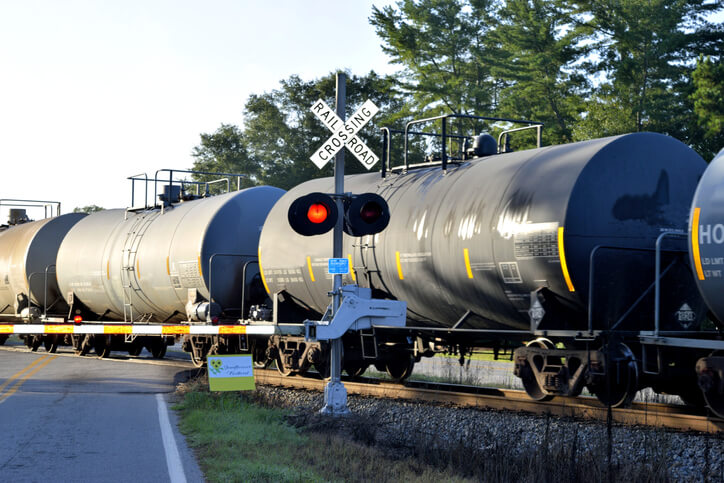The Complete Guide to Safe and Cost-Effective Transloading
As a business executive in the chemical industry, you likely already know that chemical transloading refers to the process of transferring bulk chemicals from one mode of transportation to another. It’s a useful process, but it can also pose risks. Some chemicals and blended products — though necessary to the success of our economy — can also pose significant environmental and health risks. As such, it’s imperative that these blended products are transported safely. Anyone involved in your business should be aware of the risks of chemical transloading and understand how a successful operation is run.
Understanding Chemical Transloading
Chemical transloading involves the movement of chemicals from a storage vessel — like a railcar, tanker truck, or barge — to another transportation vehicle, such as another railcar, truck or vessel. Chemical transloading is only performed when the destination cannot be reached by the initial mode of transportation or a change in transportation is imperative forcost-related reasons.
The most common types of transloaded products include anything from hazardous materials to bulk liquids and other specialized chemical products. Some examples include petrochemicals, industrial and agricultural chemicals, chemical additives, and other blended products like lubricants.
Because transloading carries certain risks, it’s typically done at specialized facilities known as transloading terminals or transfer stations. These facilities have the necessary infrastructure, loading and unloading equipment, and safety systems to ensure the process goes smoothly. Trained professionals oversee the operation to ensure it complies with regulations and the proper handling procedures.
Safety Measures and Best Practices
Many chemicals and blended products shipped long distances can be corrosive or otherwise hazardous to human health. As such, following set safety measures is key.
First, personnel are thoroughly trained on the transloading process. They must have knowledge of hazardous material handling procedures and safety protocols. They must also be familiar with the safety equipment and infrastructure used during the process. This may include safety showers, eyewash stations, fire suppression systems, spill containment measures, ventilation equipment, and personal protective equipment (PPE) for workers.
Prior to completing the transloading process, personnel should do compatibility checks to ensure the chemicals are compatible with the equipment, storage tanks, and containers. This helps prevent dangerous chemical reactions, leaks, or other safety hazards.
Transloading must adhere to applicable safety regulations and guidelines set by regulatory agencies, such as the Occupational Safety and Health Administration (OSHA). Complying with these guidelines may include following PPE safety standards, maintaining necessary permits, conducting inspections, and meeting reporting requirements.
There will also be some kind of emergency response preparedness plan on hand in case of an unforeseen incident. These plans outline procedures for addressing spills, leaks, fires, or other emergencies.
Benefits of Chemical Transloading
If you’re considering chemical transloading for your products, you might wonder if it’s worth it. After all, it is a process that involves highly specialized individuals and infrastructure to complete. So, just what are the benefits of chemical transloading, and why do so many organizations rely on it?
Increased Efficiency in Logistics and Supply Chain Management
Transloading allows for flexibility in transportation modes, which enables the use of the most suitable mode for each leg of the journey. If you choose one cost-effective mode of transportation, but it can’t take your blended product the entire journey, you can choose another for the other portion.
Cost Savings and Reduced Delivery Times
Transloading can allow a company to buy product in bulk at lower prices, and then use or distribute the product with other means to their customers. Transloading allows businesses to establish routes that minimize dollars spent per mile and optimize the use of transportation resources. This can result in huge cost savings, improved delivery times, and reduced fuel consumption.
Improved Inventory Management and Flexibility
Transloading facilities can act as intermediate storage hubs where chemicals can be consolidated and stored. Instead of maintaining large inventories at multiple locations, chemicals can be shipped in larger quantities to transloading terminals. This simplifies inventory management and reduces carrying costs.
Get the Specifics on Chemical Transloading on Your Operation
Interested in chemical transloading but not sure where to start? Everyone’s operations will be different, meaning each company needs a unique approach. So, where do you go from here? Partnering with an experienced chemical transloading provider is the answer.
At Crystal Packaging, we have over four decades of experience manufacturing and transloading blended products. Our team can walk you through the specifics of chemical transloading and help you come up with the most optimal plan for your operation.
We can also manufacture your blended products, taking even more stress off your plate. Our 70,000-square-foot facility features multiple blend tanks and more than two million gallons of storage. Additionally, our high-speed filling lines allow us to fill, label, package, and palletize containers of varying sizes, streamlining your operations and reducing the time needed to get your products where they need to be.
We also maintain a variety of industry certifications, which hold us to the highest standards in manufacturing excellence. With GMP, ECOCERT, and Safer Choice Standard accreditations, we can meet your exact needs. We also have an EPA registration and our facility is H-3 certified, should your products require those accreditations.
To date, we’ve produced more than 400 million gallons of product for more than 300 satisfied partners, and we’d love to help you, too.
Let’s Get Started
Ready to learn more about what we can do for you? Reach out to our team today.

